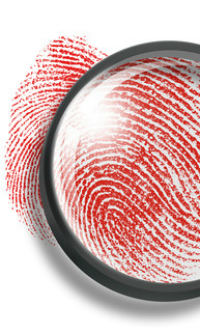Fingerprints, which are now referred to as fingermarks, have helped police to solve crimes for more than a century from the unique ridge patterns, but modern forensic techniques can extricate much more information, One of the key drivers along this route is Simona Francese’s group at Sheffield Hallam University which works in conjunction with the Home Office Centre for Applied Science and Technology.

Over the last few years, they have been pushing back the boundaries to demonstrate that compounds within the body can also be identified on fingermarks using mass spectrometry. Pharmaceuticals and their metabolites and drugs of abuse are readily detected as well as peptides and proteins that point to the gender of their owners. Now, the group has also turned its attention to blood. The presence of blood directly on a fingermark can establish a link between the identity of an individual from the ridge pattern and the events of bloodshed.
In the last two years, Francese has proved that blood can be detected on fingermarks from the intact haem and haemoglobin molecules using matrix-assisted laser desorption/ionisation mass spectrometry imaging (MALDI MSI). A subsequent report explained how they employed proteomics and MALDI MSI to confirm blood from its constituent proteins after on-fingermark digestion with trypsin and analysis of the peptides formed.
They tested two related procedures. One gave the better protein coverage but the other was quicker, taking only five minutes for sample preparation. Despite the success, there was some concern about maintaining the integrity of the fingermark ridge patterns, which are so crucial for suspect identification. As a result, they have now refined the procedure and have published a proof of concept report that details the modifications.
Trypsinisation is critical step
The critical step involves submitting the blood proteins to digestion with trypsin. In initial experiments, volunteers pricked a clean finger and deposited a bloody fingermark. Trypsin solutions with concentrations of 125-500 µg/mL were spotted over the fingermark and left for three hours before MALDI MSI and ion mobility MS/MS of the resultant peptides by scanning across the sample.
A number of proteins were identified from their peptides, including apolipoprotein A1, complement C3, serotransferrin, α2-macroglobulin as well as α-haemoglobin. The greatest peptide intensities were achieved with 250 µg/mL trypsin, with the 500 µg/mL solution giving poor intensities due to an unsuitable protein/trypsin ratio.
In the next stage, concentrations of 125-250 µg/mL were used to treat quarter split blood marks using a commercial acoustic reagent spotter that positioned small spots of the enzyme around the mark. However, this procedure was unsatisfactory as the trypsin spots ran into each other due to the viscosity of the blood and insufficient drying of the trypsin solution.
Linking biometric and bloodshed information
Better results were obtained with a commercial sprayer that was also used to apply the MALDI matrix solution. Higher trypsin concentrations led to less uniform sprays, capillary blockage and syringe breakage so the maximum concentration was reduced to 200 µg/mL. The peptides were again successfully imaged and used to identify the proteins present.
Not all peptides produced a continuous ridge pattern when they were imaged. One that was attributed to α-haemoglobin generated a speckled image that could not be explained at this stage.
Following the successful nature of these experiments, the team plan further work to allow higher trypsin concentrations and to balance the original protein and trypsin concentrations for the highest blood peptide yields. Their earlier studies showed that nine-year-old blood evidence could be tested successfully but they will reinforce this to test the robustness of the technique.
Once the new technique is fully developed and accepted in the forensic world, the evidence can be used in criminal investigations to establish the presence of blood when very minor traces are present. It may also be able to distinguish between a fingermark left by a bloodied hand and a mark left on a bloody surface.
Establishing a link between the biometric information from the ridge pattern and the event of bloodshed “will inevitably have a significant impact on the overall criminal justice system as it will inform investigations and strengthen judicial debates,” they concluded.
No comments:
Post a Comment